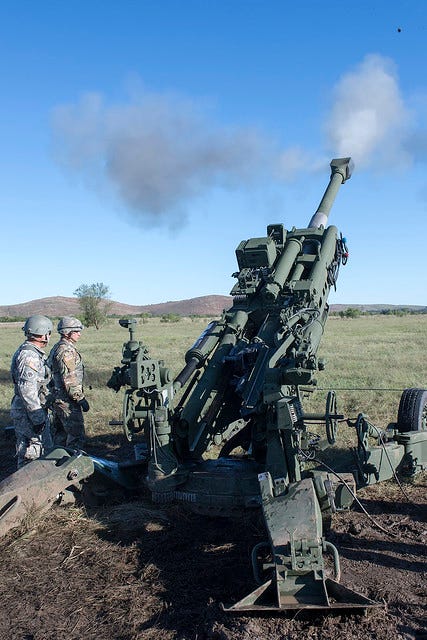Days of Supply (DoS) Versus Required Supply Rate (RSR) (Class V-Ammunition)
Members of the Charlie Company, 1st Battalion, 160th Field Artillery, 45th Infantry Brigade Combat Team, fire their new M777A2 155mm Howitzers during training exercises at Fort Sill, Oklahoma, Sept. 27. The A2 canons use GPS to determine their location making emplacement much quicker for the gun crews and reducing time between fire missions. They are also capable of coordinated fires with other artillery platforms to include the M119A3 105mm Howitzer and the M109A6/7 Paladin. US Army National Guard photo by Maj. Geoff Legler
Ammunition terms are often confusing and do not translate well when mixed with terms outside munitions-related areas. One such example is that of Days of Supply, a term often used but rarely explicit in meaning.
Days of Supply
At face value, the amount of supply needed for a given day. An older version of the Department of Defense Dictionary of Military and Associated Terms defined for days of supply initially asked to see—one day’s supply:
“one day’s supply — (*) A unit or quantity of supplies adopted as a standard of measurement, used in estimating the average daily expenditure under stated conditions. It may also be expressed in terms of a factor, e.g., rounds of ammunition per weapon per day.”
It does not help that the example used was a factor for ammunition. Luckily, the Australian Army’s Quick Decision Exercise, Plan a Distribution Point, offers a more specific definition.
“The term DOS (days of supply) is used to describe the rate at which supplies are consumed in one day by a known dependency. DOS is used to determine the broad stocking levels of the force. DOS will vary depending on the size of the force, the type of operation, the tempo and the environmental conditions.”
What can be derived from the two definitions is that days of supply (DoS) is a standard measurement resulting from a standard rate. One that makes applying days of supply to munitions expenditures almost impossible to express. But one that can be calculated for meals (operational rations), water (consumption factors in gal/person/day), and fuel (vehicle consumption (gals/hr)).
Required Supply Rate
That is why the standard ammunition term used to express the amount of munitions needed for the day is the required supply rate (RSR). The Army Techniques Publication 3-09.23 for Field Artillery Battalion defines the RSR as the amount of ammunition expressed as:
Rounds per weapon per day for ammunition items fired by weapons,
Other units of measure per day for bulk allotment,
Other items are estimated to be required to sustain operations of any designated force without restriction for a specified period.
Leaders use the required supply rate (RSR) to outline their ammunition needs for planned operations over specific periods. These requests are forwarded up through the chain of command for consolidation. Based on these requests and other factors, commanders at each level establish a controlled supply rate (CSR) to manage ammunition distribution within their command.
References
ATP 3-09.23, Field Artillery Cannon Battalion, 24 September 2015
ATP 4-35, Munitions Operations, 31 January 2023
ATP 5-0.2-1, Staff Reference Guide Volume I Unclassified Resources, 07 December 2020
Joint Publication 1-02, Department of Defense Dictionary of Military and Associated Terms, 19 August 2009 [Inactive]
Australian Army, Quick Decision Exercise, Plan a Distribution Point, May 2019




